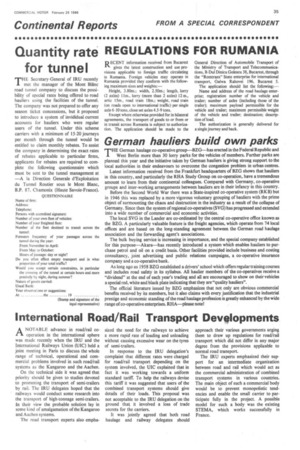International Road/Rail Transport Developments
Page 37

If you've noticed an error in this article please click here to report it so we can fix it.
il NOTABLE advance in road/rail co operation in the international sphere was made recently when the IRU and the International Railways Union (UIC) held a joint meeting in Paris to discuss the whole range of technical, operational and commercial problems involved in such road/rail systems as the Kangaroo and the Aachen.
On the technical side it was agreed that priority should be given to studies devoted to promoting the transport of semi-trailers by rail. The IRU delegates hoped that the railways would conduct some research into the transport of high-tonnage semi-trailers. In their view the probable solution lay in some kind of amalgamation of the Kangaroo and Aachen systems.
The road transport experts also empha
sized the need for the railways to achieve a more rapid rate of loading and unloading without causing excessive wear on the tyres of semi-trailers.
In response to the IRU delegation's complaint that different rates were charged for road/rail transport depending on the system involved, the UIC explained that in fact it was working towards a uniform standard tariff. To help the railways devise this tariff it was suggested that users of the combined transport systems should give details of their loads. This proposal was not acceptable to the IRU delegation on the ground that it involved a loss of trade secrets for the carriers.
It was jointly agreed that both road haulage and railway delegates should
approach their various governments urging them to draw up regulations for road/rail transport which did not differ in any major degree from the provisions applicable to normal road transport.
The IRU experts emphasized their support for an intermediate organization between road and rail which would act as the commercial administration of combined transport systems in various countries. The main object of such a commercial body would be to prevent monopolistic tendencies and enable the small carrier to participate fully in the project. A possible model for such a body was the existing STEMA, which works successfully in France.




























































































































